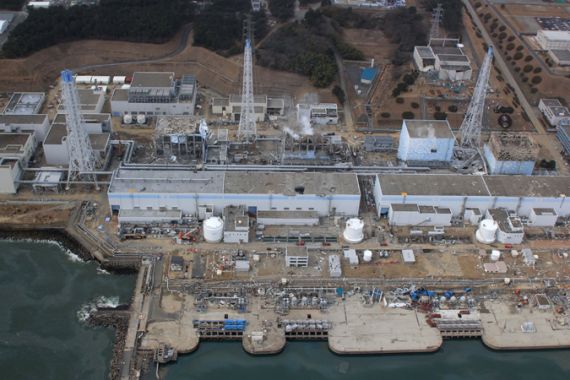Japan urged to extend nuclear exclusion zone
Radiation levels in village 40km from tsunami-damaged plant exceed “operational criteria for evacuation”, IAEA warns

The UN nuclear watchdog has suggested Japan consider widening an evacuation zone around a tsunami-damaged nuclear plant as radiation continues to leak into seawater near the plant.
The International Atomic Energy Agency (IAEA) said on Thursday radiation measured at the village of Iitate, 40km from the crippled Fukushima Daiichi nuclear plant, exceeded a criterion for evacuation.
Keep reading
list of 4 itemsLost Futures
Photos: Greek valley that became a lake stirs drought debate
Botswana threatens to send 20,000 elephants to Germany
Radioactivity in the seawater has reached more than 4,000 times its legal limit, the Reuters news agency reported.
“We have advised (Japan) to carefully assess the situation and they have indicated that it is already under assessment,” Denis Flory, the IAEA’s deputy director general, said.
Radiation in water of an underground tunnel outside a turbine building of No.2 reactor at Fukushima Daiichi nuclear plant was more than 10,000 times above normal levels in reactors, the plant operator was quoted by Kyodo news agency as saying on Thursday.
The operator also found radiation in groundwater near a turbine building of the No.1 reactor of the Fukushima Daiichi plant, Kyodo added. And an abnormal level of radioactive caesium has been found in beef from the area, it said.
Concerns over radiation spreading beyond Japan grew again after Singapore detected radiation nine times the limit in cabbages imported from Japan while the United States reported small levels of radiation in milk samples on its west coast.
Japan has ordered those within a 20km radius from the plant to leave and is encouraging those living in a 20-30km ring to do the same, and if they do not, to stay inside.
Tens of thousands of people, including farmers and their families, have been evacuated from the exclusion zone around the plant.
Another 130,000 who live in a 10km band beyond the exclusion zone have been advised either to leave or stay indoors.
There is no indication how long they will be homeless.
Contaminated victims
Kyodo news reported on Thursday that radiation fears have prevented authorities from collecting as many as 1,000 bodies of victims of the earthquake and tsunami from within the 20-kilometre-radius evacuation zone, quoting police sources.
The authorities are now considering how to collect the bodies, given fears that police officers, doctors and bereaved families may be exposed to radiation in retrieving the radiation-exposed bodies or at morgues, according to the sources.
”Measures that can be taken vary depending on the level of radiation, so there need to be professionals who can control radiation,” said an expert on treating people exposed to radiation. ”One option is to take decontamination vehicles there and decontaminate the bodies one by one.”
TEPCO, the company that runs the plant, said it was inevitable it would have to scrap four of its six reactors at the plant. Scrapping the damaged nuclear reactors may take decades, said Japan’s Nuclear and Industry Safety Agency.
The Japanese Prime Minister Naoto Kan echoed this saying the Fukushima plant must be scrapped, Kyodo news reported on Thursday.
Prime minister criticised
The IAEA’s suggestion came as the opposition criticised Kan for failing to expand the evacuation zone.
Greenpeace this week said it had confirmed radiation levels in Iitate village high enough to evacuate, but Japan’s nuclear safety agency has rebuffed the environmental group’s call.
Meanwhile Nicolas Sarkozy, president of nuclear-dependent France, arrived in Japan on Thursday, the first leader to visit since a devastating earthquake that was followed by a tsunami sparked the world’s worst nuclear crisis since Chernobyl in 1986.
Sarkozy, who chairs the G20 and G8 blocs of nations, is expected to meet Kan to show support for Japan’s efforts to end its nuclear crisis.
France has flown in experts from its state-owned nuclear reactor maker Areva CEPFi.PA, while the United States has offered robots to help repair the crippled plant north of Tokyo.
Further assistance is expected as the US military on Wednesday ordered a Marine unit specialising in emergency nuclear response to deploy to Japan and assist local authorities in addressing the massive crisis, officials said.
Some 155 Marines from the service’s Chemical Biological Incident Response Force are scheduled to leave the United States on Thursday and arrive in Japan on Friday, a US defence official told the AFP news agency.
The CBIRF team, trained in identifying chemical agents, monitoring radiation levels and decontaminating personnel, would not participate in the frenzied efforts to stabilise the reactors of the nuclear plant.
The nuclear plant was also hit by several explosions, triggering fears of a catastrophic meltdown as radiation has wafted into the air and seeped into the ocean.
US military personnel are currently barred from penetrating an 80km radius around the stricken plant, far exceeding the 20km exclusion zone imposed by the Japanese government.
Japan is also facing a humanitarian calamity triggered by the earthquake and tsunami, which has left more than 27,500 people dead or missing.
Experts warn that tsunami survivors mourning lost loved ones and struggling to replace shattered homes and workplaces also face daunting mental health concerns.